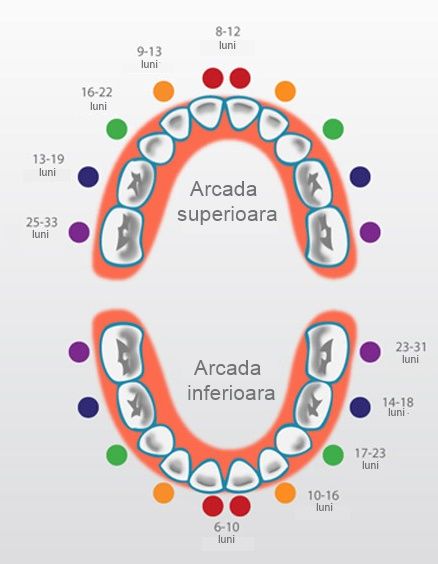
Tooth eruption in children occurs in two phases: Temporary tooth eruption and permanent tooth eruption.
- Temporary dental eruption (deciduous) involves the appearance of 2 lower median incisors (between 6 and 9 months), 2 upper median incisors (between 8 and 10 months), 4 lateral incisors (between 10 and 12 months), canines (between 14 and 18 months), first molar (12-14 months), 2nd molar (20-30 months).
- Final (permanent) tooth eruption involves the appearance of lower incisors (6-8 years), upper incisors (7-9 years), lower canines (10-11 years), upper canines (11-12 years), premolars (10-12 years), first molar (6-7 years), 2nd molar (11-13 years), 3rd molar (wisdom, 17-21 years).
During the period of tooth eruption children may experience profuse salivation, restlessness, sleep disturbance, slight increase in temperature, reddening of the gums. Baby discomfort before the age of 5-6 months is extremely rare due to teething.
For pain relief it is recommended to rub the child's gums with the fingertip (washed and disinfected), use special teething rings, crackers (if he is at the age where he eats solid food), or toothache relief gels.
Tooth eruption can sometimes be atypical, with some teeth being late to erupt and being overtaken by the next teeth; there are cases when the upper lateral incisors erupt before the middle ones.
Dental buds are formed during intrauterine life, that's why the mother's nutrition during pregnancy is very important. It must contain calcium and phosphorus which come mainly from milk and its derivatives, meat (fish). Calcium, vitamin C and D supplements are also important.
Once the teeth erupt, the first teeth require special attention from parents because, even if they are temporary teeth, it is absolutely mandatory to take care of them. There are special toothbrushes and toothpaste for young children (0-2 years, 0-3 years). Any child who has teeth should have their teeth brushed, even if they are only 6 months old.
 RO
RO  EN
EN 